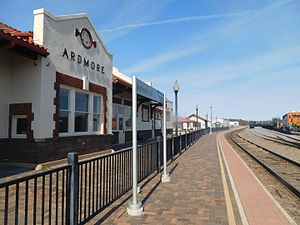Ardmore, OK | ||||||||||||||||||||||||||||
|---|---|---|---|---|---|---|---|---|---|---|---|---|---|---|---|---|---|---|---|---|---|---|---|---|---|---|---|---|
 Ardmore station in February 2017 | ||||||||||||||||||||||||||||
| General information | ||||||||||||||||||||||||||||
| Location | 251 East Main Street Ardmore, Oklahoma United States | |||||||||||||||||||||||||||
| Coordinates | 34°10′20″N97°07′32″W / 34.1721°N 97.1255°W | |||||||||||||||||||||||||||
| Owned by | City of Ardmore | |||||||||||||||||||||||||||
| Line(s) | BNSF Railway Red Rock Subdivision | |||||||||||||||||||||||||||
| Platforms | 1 side platform | |||||||||||||||||||||||||||
| Tracks | 2 | |||||||||||||||||||||||||||
| Construction | ||||||||||||||||||||||||||||
| Accessible | Yes | |||||||||||||||||||||||||||
| Other information | ||||||||||||||||||||||||||||
| Station code | Amtrak code: ADM | |||||||||||||||||||||||||||
| History | ||||||||||||||||||||||||||||
| Opened | 1909 | |||||||||||||||||||||||||||
| Rebuilt | November 16, 1915–August 7, 1917 [1] [2] | |||||||||||||||||||||||||||
| Key dates | ||||||||||||||||||||||||||||
| September 27, 1915 | Depot destroyed in explosion [3] | |||||||||||||||||||||||||||
| Passengers | ||||||||||||||||||||||||||||
| FY 2023 | 5,831 [4] (Amtrak) | |||||||||||||||||||||||||||
| Services | ||||||||||||||||||||||||||||
| ||||||||||||||||||||||||||||
| ||||||||||||||||||||||||||||
| ||||||||||||||||||||||||||||
Ardmore (Amtrak: ADM) is an Amtrak train station in Ardmore, Oklahoma. The station is serviced by the daily Heartland Flyer , which travels from Oklahoma City, Oklahoma to Fort Worth, Texas.
Contents
The station house is owned by the Ardmore Main Street Authority, which restored the station in 2015. The station currently serves as an event venue. A public park, called Depot Park, was opened on the west side of the station in 2022. [5]
